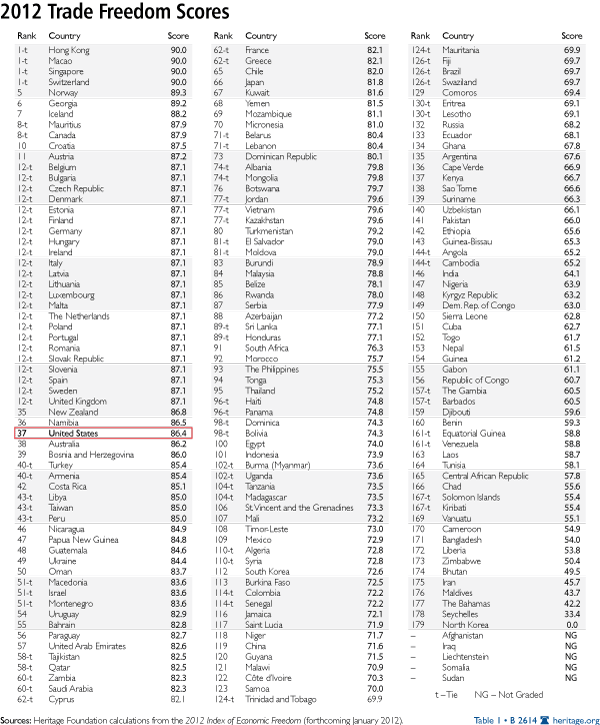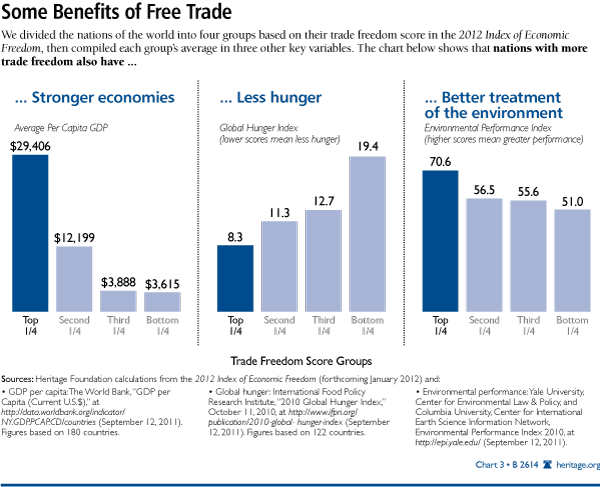Abstract: The 2012 rankings of trade freedom around the world indicate that trade freedom in the world has remained constant or regressed slightly since 2011. The lack of improvement is regrettable because countries with the most trade freedom have the highest per capita gross domestic product, the lowest incidence of hunger, and the cleanest environments. The U.S. needs to resume its global leadership on trade freedom by encouraging a successful, prompt conclusion to the Doha Round; implementing the free trade agreements with Colombia, Panama, and South Korea; and eliminating U.S. trade barriers.
The 2012 rankings of trade freedom around the world (see Table 1), developed by The Heritage Foundation and The Wall Street Journal in connection with the forthcoming 2012 Index of Economic Freedom,[1] show how countries that embrace free trade benefit compared to those that do not. The case for pending U.S. trade agreements with Colombia, Panama, and South Korea is bolstered by international statistics showing a strong correlation between trade freedom and a variety of positive indicators, including economic prosperity, low poverty rates, and clean environments.
Worldwide, the average trade freedom score fell slightly, from 74.8 to 74.5. This small drop is not necessarily cause for alarm because trade freedom remains at the second-highest level since The Heritage Foundation began tracking it in 1995.
Trade freedom scores have improved substantially since 1995, when the inaugural Index of Economic Freedom was released, but there is plenty of room for additional improvement.
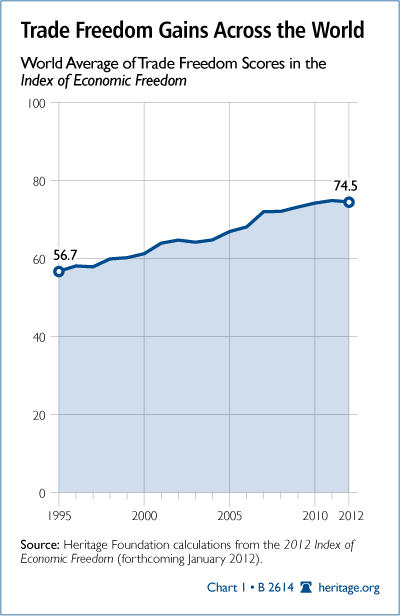
Trade On the Rise
According to the World Trade Organization (WTO), trade volume has recovered strongly from the global recession. Global exports increased 14.5 percent in 2010, and the WTO projects a 6.5 percent increase for 2011.[2]
International trade plays an increasingly significant role in the economies of the United States and other countries. Since 1960, trade as a percentage of gross domestic product (GDP) for the world has doubled. Trade as a percentage of U.S. GDP has nearly tripled, although U.S. trade volume remains lower than the world average due to the large U.S. internal market.
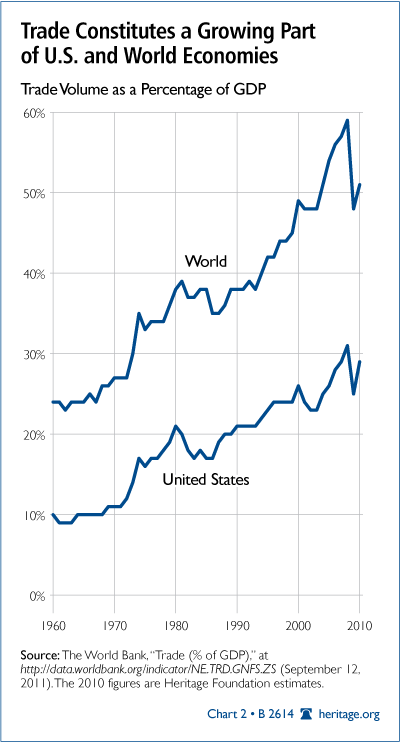
Why Trade Freedom Matters
A comparison of the countries with the best trade scores in the 2012 Index of Economic Freedom with those that have the worst scores demonstrates the importance of trade freedom. Countries with the most trade freedom have higher per capita GDPs, lower incidences of hunger, and cleaner environments. (See Chart 3.)
Special interest groups often complain that “unfair” foreign competition destroys jobs, but countries with the highest trade barriers have nearly twice the unemployment rate of countries with the most trade freedom.[3] In the United States, the trade deficit and the unemployment rate usually have an inverse relationship. When the trade deficit increases, the unemployment rate decreases, and vice versa. For example, in 2009, the U.S. trade deficit shrank by 46 percent, and the unemployment rate increased by 60 percent.[4]
Many critics of trade deals, such as the North American Free Trade Agreement (NAFTA) and the WTO agreement, argue that free trade benefits big multinational corporations and “the rich” at the expense of everyone else. In fact, as Chart 4 shows, poverty rates are lower in countries with low trade barriers.
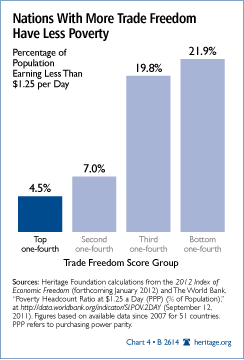
One common measure of income inequality is the Gini coefficient. The larger the Gini coefficient, the greater the amount of inequality in a country. Chart 5 suggests that income inequality is greater in countries in which there is evidence of high levels of corruption and crony capitalism.
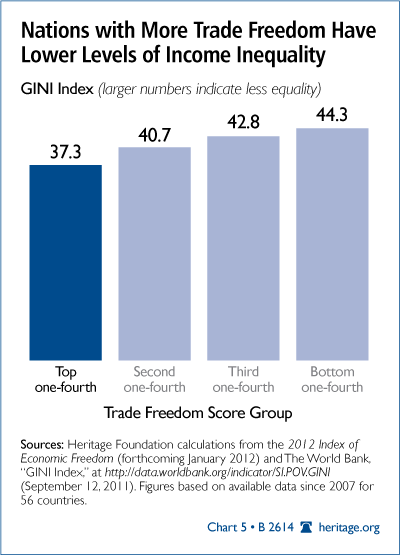
The U.S. trade deficit has led some Members of Congress to call for new trade barriers, but they would better serve their constituents by restraining excessive government spending and the resulting federal budget deficit. Trade deficits are driven more by macroeconomic factors than by trade policy. As Chart 6 shows, high trade barriers do not necessarily generate trade surpluses as a percentage of GDP.
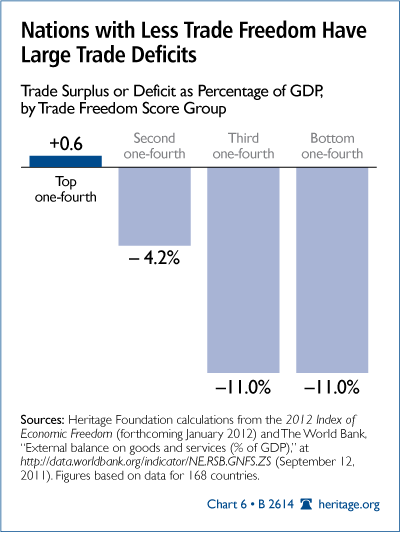
World Trade Needs U.S. Leadership
The United States can take several practical steps to encourage trade freedom. The Obama Administration can begin by setting a firm deadline for concluding the Doha Development Round of trade negotiations. The Doha Round’s goal was to promote economic development through trade. Talks have been underway for 10 years, and the United States should lead them to a successful conclusion instead of allowing them to drag on indefinitely.
The United States should also encourage other countries’ efforts to reduce trade barriers. For example, leaders in Africa are discussing a 26-country free trade area.[5] U.S. programs like the Generalized System of Preferences, African Growth and Opportunity Act, and Andean Trade Preference Act promote mutually beneficial trade and growth. These programs should be expanded to include more categories of imports and extended on a long-term basis.
The Obama Administration and Congress will hopefully enact free trade agreements with Colombia, Panama, and South Korea, which have been pending for years. In recent years, the United States has remained on the sidelines while other countries have aggressively moved forward with trade deals modeled on U.S. agreements, such as NAFTA. The Administration should follow up by exploring multilateral opportunities to reduce trade barriers in the Pacific, in the Western Hemisphere, across the Atlantic, and anywhere else it can find willing partners.
However, the United States need not wait for long, uncertain negotiations to reduce its own self-destructive trade barriers. Congress can take the first steps by eliminating:
- Tariffs on imported shoes and clothing. These tariffs, which have been called America’s most regressive tax, cost Americans billions of dollars per year.[6]
- Restrictions on sugar imports. Sugar tariffs are the modern version of the Molasses and Sugar Acts, which contributed to the American Revolution. They should be as offensive to lawmakers today as they were to colonists in the 1700s.
- Job-killing anti-dumping laws. These laws reduce competition and increase the price of inputs for U.S. producers.[7] At the very least, Congress should require the government to conduct a cost-benefit analysis before considering any new anti-dumping duties.
- “Buy American” laws. Requirements for governments at the state, local, and federal levels to use domestically produced products when lower-priced imports are available increase government spending, leading to higher taxes or larger budget deficits. They also indirectly limit opportunities for competitive U.S. companies to sell their products to other governments.
- The Merchant Marine Act of 1920 (Jones Act) and the Passenger Vessel Services Act of 1886. These laws require ships moving from one U.S. port to another to be U.S.-made and U.S.-crewed, thereby artificially increasing cargo transportation costs.
Conclusion
The 2012 rankings of trade freedom show that people in the United States and around the world benefit when their governments allow them to trade freely. Approval of pending trade agreements between the United States and Colombia, Panama, and South Korea would generate positive results including greater prosperity and less poverty in all four countries.
—Bryan Riley is Jay Van Andel Senior Analyst in Trade Policy in the Center for International Trade and Economics at The Heritage Foundation. Ambassador Terry Miller is Director of the Center for International Trade and Economics and Mark A. Kolokotrones Fellow in Economic Freedom at The Heritage Foundation.
Appendix
Methodology
The trade-freedom scores reported in this paper are based on two inputs: trade-weighted average tariff rates and non-tariff barriers (NTBs).
Different imports entering a country can, and often do, face different tariffs. The weighted average tariff uses weights for each tariff based on the share of imports for each good. Weighted average tariffs are a purely quantitative measure and account for the basic calculation of the score using the following equation:
Trade Freedomi = (Tariffmax – Tariffi) / (Tariffmax – Tariffmin) x 100 – NTBi
where Trade Freedomi represents the trade freedom in country i, Tariffmax and Tariffmin represent the upper and lower bounds for tariff rates, and Tariffi represents the weighted average tariff rate in country i. The minimum tariff is naturally zero, and the upper bound was set as a score of 50. An NTB penalty is then subtracted from the base score. The penalty of 5, 10, 15, or 20 points is assigned according to the following scale:
- Penalty of 20: NTBs are used extensively across many goods and services and/or act to impede a significant amount of international trade.
- Penalty of 15: NTBs are widespread across many goods and services and/or act to impede a majority of potential international trade.
- Penalty of 10: NTBs are used to protect certain goods and services and impede some international trade.
- Penalty of 5: NTBs are uncommon, protecting few goods and services, and/or have very limited impact on international trade.
- No penalty: NTBs are not used to limit international trade.
Both qualitative and quantitative information is used to determine the extent of NTBs in a country’s trade policy regime. Restrictive rules that hinder trade vary widely, and their overlapping and shifting nature makes it difficult to gauge their complexity. The categories of NTBs considered in the trade freedom penalty include:
- Quantity restrictions: import quotas, export limitations, voluntary export restraints, import/export embargoes and bans, countertrade, etc.;
- Price restrictions: antidumping duties, countervailing duties, border tax adjustments, variable levies/tariff rate quotas;
- Regulatory restrictions: licensing; domestic content and mixing requirements; sanitary and phytosanitary standards; safety and industrial standards regulations; packaging, labeling, and trademark regulations; advertising and media regulations;
- Customs restrictions: advance deposit requirements, customs valuation procedures, customs classification procedures, customs clearance procedures; and
- Direct government intervention: subsidies and other aids; government industrial policy and regional development measures; government-financed research and other technology policies; national taxes and social insurance; competition policies; immigration policies; government procurement policies; state trading, government monopolies, and exclusive franchises.
As an example, in 2011 France received a trade-freedom score of 82.6, based on the weighted average tariff of 1.2 percent common to all European Union countries. The tariff yields a base score of 97.6, but the existence of significant French NTBs reduces the nation’s trade-freedom score by 15 points.
Gathering data on tariffs to make a consistent cross-country comparison can be a challenging task. Unlike data on inflation, for instance, countries do not report their weighted average tariff rate or simple average tariff rate every year. To preserve consistency in grading trade policy, the authors use the most recently reported weighted average tariff rate for a country from the World Bank. If another reliable source reports more updated information on a country’s tariff rate, the authors note this fact and may review the grading if there is strong evidence that the most recently reported weighted average tariff rate is outdated.
The World Bank produces the most comprehensive and consistent information on weighted average applied tariff rates. When the weighted average applied tariff rate is not available, the authors use the country’s average applied tariff rate; and when the country’s average applied tariff rate is not available, the authors use the weighted average or the simple average of most-favored-nation (MFN) tariff rates.[8] In the very few cases in which data on duties and customs revenues are not available, the authors use international trade tax data instead.
In all cases, the authors clarify the type of data used and the different sources for those data in the corresponding write-up for the trade policy factor. Sometimes, when none of this information is available, the authors simply analyze the overall tariff structure and estimate an effective tariff rate.
The trade-freedom scores for 2012 are based on data for the period covering the second half of 2010 through the first half of 2011. To the extent possible, the information considered was current as of June 30, 2011. Any changes in law effective after that date have no positive or negative impact.
Finally, unless otherwise noted, the authors used the following sources to determine scores for trade policy, in order of priority:
- The World Bank, World Development Indicators 2011 and Data on Trade and Import Barriers: Trends in Average Applied Tariff Rates in Developing and Industrial Countries, 1981–2009;
- The World Trade Organization, Trade Policy Review, 1995–2011;
- Office of the U.S. Trade Representative, 2011 National Trade Estimate Report on Foreign Trade Barriers;
- The World Bank, Doing Business 2011 and Doing Business 2012;
- U.S. Department of Commerce, Country Commercial Guide, 2008–2011;
- Economist Intelligence Unit, Country Report, Country Profile, and Country Commerce, 2008–2011; and
- Official government publications of each country.
